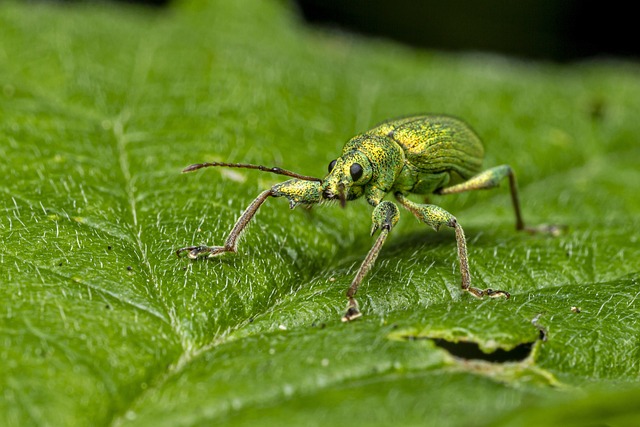Grain weevils (Rhyzopertha dominica) are common agricultural pests infesting grains like wheat, corn, barley, and rice. Measuring 4-5 mm, these brown or black beetles enter through cracks, feeding on kernel starch. Effective grain weevil pest control involves strategic measures such as proper storage practices, regular inspections, and targeted treatments. Traditional methods include insecticides and integrated pest management (IPM), with natural alternatives like pyrethrins offering safer options. Modern approaches combine traditional tactics with innovative solutions like biological agents and pheromone traps, minimizing environmental impact. Preventive measures such as using airtight containers and conducting regular inspections significantly reduce infestation risks.
Grain weevils can devastate stored grains, causing significant economic losses for farmers and food manufacturers. This article explores effective treatments to eliminate these persistent pests. We delve into their behavior, life cycle, and traditional pest control methods, while also highlighting modern, eco-friendly approaches. Additionally, we offer preventive measures to secure your grains and storage areas from these insidious invaders, focusing on key strategies for robust grain weevil pest control.
Understanding Grain Weevils: Behavior and Life Cycle
Grain weevils, scientifically known as Rhyzopertha dominica, are a significant pest in the agricultural and food storage industries. These small beetles pose a serious threat to various stored grains like wheat, corn, barley, and rice, infesting both commercial silos and household pantries. Understanding their behavior and life cycle is crucial for effective grain weevil pest control.
The adult weevils typically measure about 4-5 mm in length and are brown or black. They enter storage areas through tiny cracks and crevices, attracted by the scent of moldy or damaged grains. Once inside, they feed on the starch in the grain kernels, causing substantial damage. The female weevil lays its eggs within the grain, and the larvae hatch out, boring into the kernels to feed and grow. This life cycle can repeat over several generations if left untreated, leading to a persistent infestation. Knowing these habits allows for strategic grain weevil control measures to be implemented, including proper storage practices, regular inspections, and targeted treatments.
Traditional Pest Control Methods for Grain Weevil Infestations
Grain weevils can be persistent pests, but there are several traditional methods to combat these infestations. One common approach is the use of insecticides, which can effectively eliminate weevils in grain storage areas. These chemicals target specific stages of the weevil’s life cycle, disrupting their breeding and feeding patterns. Pyrethrins, for instance, are natural insecticides derived from chrysanthemums, offering a safer alternative with minimal environmental impact while still proving effective against grain weevils.
Additionally, integrated pest management (IPM) strategies combine various control measures. This includes physical removal of infested materials, proper storage practices like using airtight containers, and biological controls such as introducing natural predators or parasites. These traditional methods form the foundation for managing grain weevil infestations, but modern innovations and combinational approaches are continually enhancing their effectiveness in pest control.
Modern and Eco-Friendly Approaches to Eradicate Grain Weevils
In today’s world, modern and eco-friendly approaches offer effective solutions for grain weevil pest control. One such method is the use of biological agents, including natural predators and parasites that target these specific pests. Introducing beneficial insects like spider mites or certain types of wasps can help control grain weevil populations by feeding on their eggs and larvae, offering a sustainable and non-toxic alternative to chemical pesticides.
Another innovative approach involves the application of targeted chemicals in combination with modern technology. Precision spraying techniques, coupled with pheromone traps, can effectively monitor and eliminate weevils. These methods are designed to minimize environmental impact while ensuring complete grain weevil eradication. By combining these modern tactics with traditional practices, it’s possible to achieve successful grain weevil pest control that protects both crops and the ecosystem.
Preventive Measures: Securing Your Grains and Storage Areas
Preventive measures are crucial in managing and eliminating grain weevil infestations. Securing your grains and storage areas is a primary step in pest control. This involves ensuring that all stored grains are kept in airtight containers, as grain weevils require access to moisture and organic matter found in open grains. Regular inspection of these areas is also essential to identify any signs of infestation early on.
Additionally, maintaining cleanliness in storage facilities and promptly cleaning up any spilled grains can significantly reduce the risk of attracting these pests. It’s important to remember that grain weevils are excellent jumpers, so storing grains in elevated containers or bins with tight-fitting lids can further deter them. Implementing these preventive measures will create an inhospitable environment for grain weevils, thereby minimizing the chances of an infestation.
In addressing grain weevil infestations, a multifaceted approach combining traditional, modern, and eco-friendly methods proves most effective. Understanding these pests’ behavior and life cycle is key to successful elimination. Traditional pest control methods offer quick solutions, while modern techniques revolutionize the landscape with innovative, less harmful alternatives. Eco-friendly practices not only enhance storage security but also contribute to a sustainable future. Implementing preventive measures, such as secure grain storage and regular inspections, acts as a robust shield against these pesky intruders. Equipped with this knowledge, folks can now navigate and conquer grain weevil infestations effectively, securing their resources for years to come.
